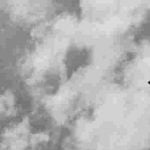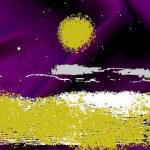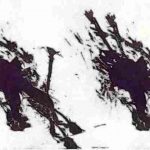“When I cannot see words curling like rings of smoke round me I am in darkness—I am nothing.” ? Virginia Woolf, The Waves
Under the weight of goose down and split spine, I lingered in Orlando. How true it was that nothing “thicker than a knife’s blade separates happiness from melancholy.”
My rapist was the knife’s blade. His act upon me made me separate—lost. And consequently, I, too, became the same sharp edge.
“I must have done something wrong to deserve this,” I whispered over the page.
“[Why] not give up thinking, and drift and dream?” Woolf answered.
“Who would believe me if I spoke?”
*
Virginia Woolf once told her biographer Nigel Nicolson, “Nothing has really happened until it has been described.”
I flip to the end of Orlando. On a blank page, I describe a frequent dream:
I’m waking up alone in the bathroom stall of the nightclub, and all I can see underneath the stall door and the floor are my rapist’s bare feet. He doesn’t move, just waits for me to come out.
I read the dream out loud as the dog curled against my thigh.
“[You] must write many letters to your family and friends, and keep a diary,” Virginia said.
My mother is at home; I call to her. My father is at home, and I call to him. My sister is at home, and I call to her. No one can hear. I sit on the toilet seat and wait for him to go away. I don’t say anything. All I can see and hear through a crack in the door is my doctor’s face. He is yelling at me and holding a vaginal clamp.
Virginia listened that night to the pen pressing into the paper. My silence settled above the bed sheets, soft on the tops of my feet.
“It happened,” I say.
I close the book and pull the blankets to my chin.
“Did you feel this way after your half-brothers touched you one at a time?” I ask her.
“How much better to sit by [yourself] like the solitary sea-bird that opens its wings on the stake,” Virginia answers.
Outside, the garbage truck’s engine hums. Its silence calms me, and I fall asleep.
*
I underline this sentence: Let me sit here forever with bare things, this coffee cup, this knife, this fork, things in themselves, myself being myself.
I press The Waves against my chest.
This was the only way to accept rape: to accept the silence of being myself. Because there is no way to escape silence after rape. It’s not passable.
*
During my recovery, I became fixated on other people’s pain: my arthritic neighbor, the homeless man outside my warm house. Every ache and stab of bone, every walk alone, hungry, I suffered. Such pain became a familiar and shared place.
I felt guilt I survived. What about the girls and boys who committed suicide? What about all the bodies dumped in landfills and deserts? What about the families that sit alone in the darkness of their children’s rooms? Would that silence be inescapable, too?
*
It’s easy to want to ignore silence, though, which was why I read Mrs. Dalloway so many times. Like Clarissa, I did what I could to suffocate the quiet: I went to parties, I slept with men I didn’t know; and I took drugs, I self-harmed.
I identified with Clarissa’s desperation to escape the world through distraction. But the distraction is short lived when she hears of Septimus’ death, the ultimate silence.
At this point, the text becomes impassable. I had to accept my mortality, like Clarissa, in order to move on.
I must face myself in the dark in total silence.
I must face the quiet. I must face myself at the center of the world, despite how painfully quiet it is.
*
Septimus led the way for both Clarissa and me. His death was an exit, a letting go: “If one were now to die, ’twere now to be most happy,” says Clarissa. His death was the only way she could realize her own happiness. She stood in her white gown, and “it was her punishment to see sink and disappear here a man, there a woman, in this profound darkness.”
The only way for me to move on was to let go of the burden rape had forced on me, to let go of the suffering that had been imposed on me.
I was no longer held down by the memory of my rape: his chaffed hands, his round face, his slender black jacket. I was no longer bound by his smell, by his breathlessness from behind me, by the fortress pain had made around my center.
The darkness was my truth. The darkness was my illumination.
*
The difficulty of reading Woolf, though, was to accept this silence, and let the words fall without anxiety, without having to always give a language to experience. My frustration became my constant attempt to give silence a name, to give suffering a name.
Woolf made the act of not knowing OK. For years I had asked the questions: Why me? Was this my fault? Will I get better? Will I love myself again?
These questions demanded answers, and my demand on them became a limit to my own recovery. That’s the limit of pain: to think I can know every feeling.
Yes, these were important questions, but I had to be OK with never having the answers. I had to embrace the silence.
I remember Woolf unraveling this for me in “The Mark on the Wall”:
And if I were to get up this very moment and ascertain that the mark on the wall is really what shall we say? The head of a gigantic old nail . . .which has now, owing to the patient attrition of many generations . . . revealed its head above the coat of paint . . . what should I gain? Knowledge? Matter for further speculation? I can think sitting still as well as standing up. And what is knowledge?
Will I ever forgive him?
If I knew the answer,
would I feel—
Free?
*
Upon completion of Mrs. Dalloway, Woolf wrote in the introduction to the Modern Library Edition “it is difficult—perhaps impossible—for a writer to say anything about his own work. All he has to say has been said as fully and as well as he can in the body of the book itself…Once a book is printed and published it ceases to be the property of the author; he commits it to the care of other people.”
Virginia’s books have always been my books. Her books became a space both passable and impassable, a space in life I couldn’t enter in life. Reading was the one place I could go if no one listened. The page accepted my silence.
Sources
Nicolson, Nigel. Virginia Woolf. Viking, 2000. Print.
Woolf, Virginia. Mrs. Dalloway. New York: Harcourt, Brace and Co, 1925. Print.
Woolf, Virginia. Orlando: A Biography. London: Published by Leonard & Virginia Woolf at the Hogarth Press, 1933. Print.
Woolf, Virginia. The Waves. London: Published by Leonard & Virginia Woolf at the Hogarth Press, 1933. Print.
Woolf, Virginia. The Mark on the Wall and Other Short Fiction. “The Mark on The Wall.” Oxford University Press, USA, 2008. Print.
Loren Kleinman : “I’ve published four books of poetry, which where Top 100 Amazon Bestsellers, a memoir, and a collection of essays and interviews about the indie writing life, which included James Franco. In addition, my nonfiction has been published in The New York Times, Cosmopolitan, Redbook, Woman’s Day, Seventeen, Good Housekeeping and The Huffington Post, while my poetry has appeared in more than 50 journals such as Drunken Boat, The Moth, Columbia Journal, and Patterson Literary Review. I also run an author interview series on The Huffington Post.”





Leave a Reply